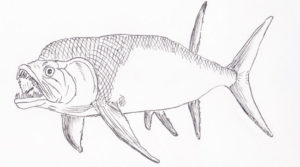Prehistoric Fish Skeleton Goes on Display
The almost complete fossilised skeleton of a giant, swift swimming and deadly Cretaceous predator (Xiphactinus) is going on display for the first time at a Canadian museum. The Cretaceous may be associated with fearsome reptiles, both on land and in the water, but the plesiosaurs, ichthyosaurs and mosasaurs did not have everything their own way, as some of the nastiest fish ever to evolve also made their appearance in the late Mesozoic.
Xiphactinus
The fossilised fish, an Xiphactinus (pronounced (zee-fak-tin-us) measures nearly six metres long and this weekend it goes on display at the Canadian Fossil Discovery Centre in the town of Morden (Manitoba, Canada). The Canadian Fossil Discovery Centre houses one of the most extensive fossil collections of marine reptiles in the whole of Canada and the dedicated team of researchers and their assistants are constantly searching the surrounding countryside to find more specimens to add to their collection.
An Illustration of Xiphactinus

The Xiphactinus drawing that was commissioned by Everything Dinosaur as the company prepares for the arrival of the CollectA Xiphactinus 1:40 scale replica.
Picture Credit: Everything Dinosaur
The museum is perhaps best known for its superb collection of mosasaur fossils, including the famous mosasaur known as “Bruce”, perhaps the best preserved of all the Canadian fossil mosasaur material.
Xiphactinus Fossil
The Xiphactinus fossil has been carefully removed from a dig site, a location that was first identified as having excellent fossil finding potential when part of the huge fish’s skeleton was discovered eroding out of sediment back in the summer of 2009.
The fossil is part of a collection of specimens, including mosasaur vertebrae and the leg bones of a giant, prehistoric seabird Hesperornis that have been discovered at the site. They date from approximately 80 million years ago, a time when the Americas was effectively divided in two by a huge, shallow tropical sea (The Western Interior Seaway).
Xiphactinus (the name means “swift swordfish”), was a powerful hunter, cruising the surface waters of the Western Interior Seaway and hunting virtually any animal that it could fit inside its cavernous mouth. A member of the teleost fish family (bony fishes), a number of specimens of Xiphactinus have been unearthed, the first being found in Kansas in the 1850s. The rather compressed and flattened face of this large fish has led to it being nicknamed “the bulldog fish” and it has been described as the ugliest fish to have ever existed.
Perhaps the most famous fossil of Xiphactinus is the amazing “fish within a fish” specimen. George Sternberg, (a member of the famous Sternberg family who between them discovered a number of prehistoric animal specimens in North America) found this fossil in 1952 , it revealed a Xiphactinus with a fish measuring nearly 2 metres long in its gut. This was the last meal that this Xiphactinus ate and it probably was the cause of its death. With their ability to open their mouths very wide, these fast swimming predatory fishes were capable of swallowing large prey, however, in this instance this particular Xiphactinus probably had a mouth that was bigger than its stomach.
To view a 1:40 scale replica of Xiphactinus and other prehistoric animal scale models: CollectA Deluxe Prehistoric Life Models.






Leave A Comment